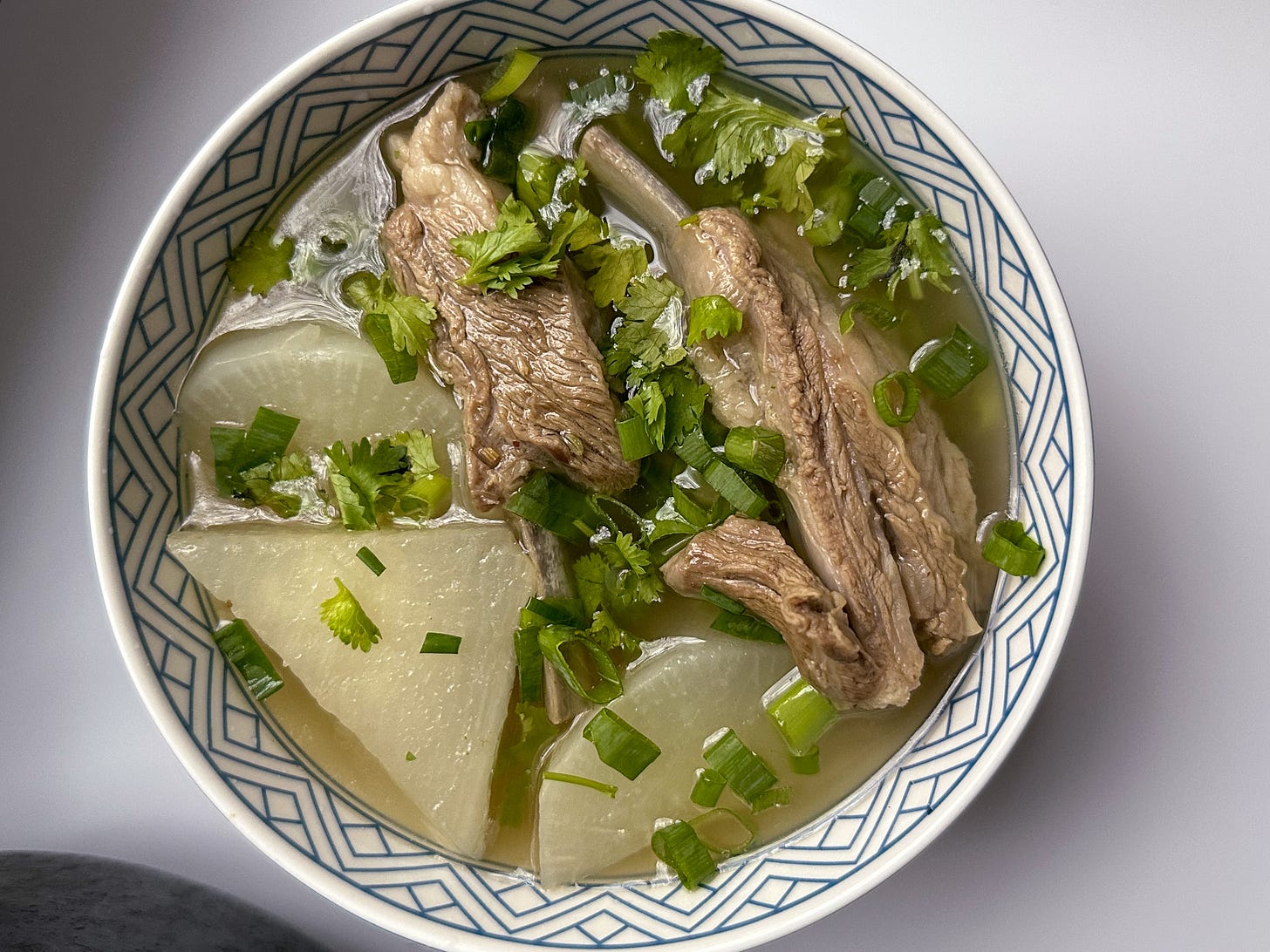Happy (almost) winter solstice! It’s celebrated in China as Dongzhi festival and we’re recreating a Sichuan tradition by making a lamb stew (羊肉萝卜汤). Hope you have a laid-back and warm holiday season!
Long before I started to go to the farmer’s market to check the ripest summer tomatoes, my family had been practicing seasonal eating for years. My grandma's go-to line was, "Eating daikon radish in winter and ginger in summer keeps the doctor away," as her way of nudging me toward a healthier diet. As winter sets in, my parent’s home would be filled with the scent of boxes of local tangerines and oranges. Part of the reason was scarcity. It wasn't until the 1980s that fruits like bananas and red apples, which weren't grown locally in Sichuan, became dietary staples.
More fundamentally, eating habits revolve around the 24 Chinese seasonalities or solar terms (jie qi, 节气), a practice steeped in Chinese farming and cooking for millennia. Philosophers like Confucius endorsed “when it’s not in season, don’t eat it” (不时不食). Some of these solar terms are tied to traditional festivals, for example, during Qingming (Tomb Sweeping Festival), we eat zong zi, sticky rice wrapped in bamboo leaves. Others are more regional; during the winter solstice (dongzhi, 冬至), one of the most important solar terms when family reunite, parts of China celebrates with tang yuan (sticky rice balls).
In Sichuan, my family gathers to savor lamb stew hot pot on the day in the shortest daylight. Specialized lamb restaurants are bustling, simmering milky lamb soup with tender meat, offals, and daikon radish. Across different regions, lamb stew or soup is a winter comfort food and takes on various forms: in Shaanxi, it pairs with hand-torn flatbread; in Beijing, it arrives in a copper hot pot.
Lamb has long symbolized delicacy in the Chinese language. Both Chinese words “beauty”(美) and “umami” (鲜) consists the the character of lamb (羊). According to traditional Chinese medicine (TCM), lamb has yang energy, warming the body and aiding blood circulation. Daikon radish, on the other hand, brings a cooling and mild element, balancing the lamb's hot energy. Like my grandma, Chinese eating therapy treasures daikon radish. A bowl of hearty lamb stew with soft, tender daikon radish becomes a winter essential, nourishing both body and soul.
During my teenage years, I held skepticism toward these traditional dietary practices, hoping for McDonald's on every single holiday and birthday. As I started cooking for myself, cravings led me back to foods with unexpected emotional weight, like this lamb stew. It might not cure all my winter blues, it certainly makes them more bearable.
Here’s my home version of the lamb stew, with a Sichuan style dipping sauce. Watch me make it here!
(Read more about eating with Chinese solar terms from Megan Zhang and Madame Huang).
The recipe
Servings: 4-6
1 kg lamb ribs or chops
500 g daikon radish
2 Scallion
1 red onion
15 g ginger
1 tsp fennel seeds
1 tsp Sichuan pepper
1 bay leaf
1 dried tangerine (optional)
salt
sugar
1/2 tsp white pepper
boiling water
for the dipping sauce (for each bowl)
2 tsp furu (fermented bean curd) or chili sauce, chili oil
2 cloves grated garlic
1 Thai Chili
chopped cilantro
chopped scallion
optionally add more soy sauce or salt
Instructions
Soak the lamb in cold water for about 1 hour, then rinse it under cold water, drain, and pat dry with paper towels. Peel and chop the daikon radish into big chunks.
Heat a large cast-iron pot over medium heat. Add lamb pieces without oil and sear until some fat renders. Then add enough boiling water to cover the lamb. Bring it to a simmer, skim off any foam, and add aromatics and spices. Stew covered for 45 minutes to 1 hour.
Remove the spices and aromatics, add the daikon radish, and stew for another 30 minutes until the lamb is fork-tender and the radish is soft. Adjust the cooking time if needed. Skim off any excess fat from the surface if desired. Season with salt, white pepper and sugar.
For the dipping sauce, mix fermented bean curd, chopped Thai chili, chopped scallion and cilantro, and a ladleful of warm lamb soup in a bowl.
Serve the soup hot and enjoy by dipping the meat and daikon radish into the sauce. We normally make this into a hot pot or served with steamed rice.
Notes on preparation
Both lamb chops and lamb ribs work well (in the photos I used ribs); the former is leaner, while the latter is fattier. In Berlin, fresh lamb cuts are available in Turkish markets, and daikon radish can now be found not only in Asian grocery stores but also in selected German stores.
If lamb isn't preferred, substitute it with beef shanks or pork ribs.
While aromatics and spices are recommended, they're not mandatory. Feel free to use what you have; I combined red and green Sichuan peppercorns based on Chef Wang Gang’s advice. Some Chinese chefs suggest avoiding spices like cinnamon sticks and star anise as they can be overpowering.
Leftovers can be used to make a flavorful noodle bowl with glass or wheat noodles—the best broth!








My friend and I recently bought a whole lamb shank, and had it cut into cubes (bone in) to make a Bún Bò Huế flavoured lamb stew. In addition to the meat for our planned stew, there was enough left for us to each set aside some in our freezers.
Shank is a much tougher cut than chops and ribs; given the long cooking time I think it will do well in this recipe. Do you have any thoughts on whether I should save my lamb shank for another recipe, and buy the more tender cuts to make this?
ps: I’ve been dreaming about making this since you recently re-posted it, but I already had plans to make the other stew.